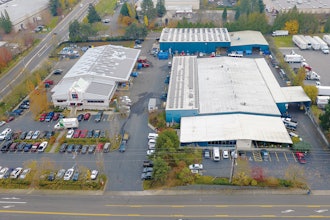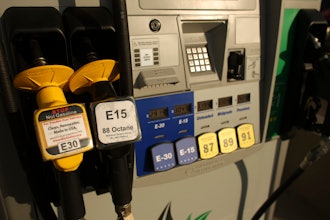TRENTON, N.J. (AP) -- Samples of milk, air and rainwater in New Jersey show no sign of elevated radiation from the Japan nuclear disaster, the state's top environmental official said Wednesday.
Environmental Protection Commissioner Bob Martin said milk samples taken last week show no signs of elevated radiation. He said preliminary air samples show trace amounts of radioactivity, but at levels far below those considered hazardous to human health. Samples of precipitation show trace amounts of Iodine-131, but not enough to cause concern, he said.
"We're seeing virtually nothing right now -- we've tested the water, we've tested the milk, and we're testing rainwater," Martin said. "In rainwater, we're seeing mere traces."
He said he does not expect the situation to worsen.
Martin was among five environment and security experts to testify at a briefing on nuclear power plant safety and emergency preparedness at the Statehouse on Wednesday.
The most densely populated state has four nuclear reactors, including Oyster Creek, the nation's oldest. Two of the reactors, Oyster Creek in Ocean County and Hope Creek in Salem County, are a similar design to two of the damaged Japanese reactors.
Martin and Charles McKenna, director of the state Homeland Security office, said it would be nearly impossible for a nuclear accident similar to the one unfolding in Japan to happen in New Jersey. That's because New Jersey doesn't experience earthquakes nearly as powerful as the quake that hit Japan; the state does not experience tsunamis; and its four nuclear power plants are built with sturdier backups than the reactors of similar design in Japan, the officials said.
New Jersey gets about half its electricity from nuclear power.
The biggest threat to New Jersey's nuclear generating plants is hurricanes, the officials said.
Still, the officials said there are lessons to be learned from the Japan disaster.
Gov. Chris Christie has convened a task force to review safety and emergency response plans.
Federal nuclear regulators are considering expanding planning requirements for evacuation from the current 10-mile radius to 25 or even 50 miles in wake of the Japan crisis, McKenna said.
Those proposals are in the preliminary stages, however, and may not be deemed necessary, Martin said.
Assemblyman John McKeon, a South Orange Democrat who chairs the Assembly environmental committee, wondered how it would be possible to evacuate large numbers of summer tourists from Long Beach Island in the event of a nuclear accident.
McKenna said it's often better to advise residents to stay indoors until a radiation cloud passes, so a large-scale evacuation wouldn't be necessary.
New Jersey officials also said it's time to renew cooperation with neighboring states operating nuclear facilities near the New Jersey border. New York's Indian Point nuclear plant is 15 miles from New Jersey and Pennsylvania's Limerick Nuclear Power Plant is 25 miles from the New Jersey state line.
Environmental Protection Commissioner Bob Martin said milk samples taken last week show no signs of elevated radiation. He said preliminary air samples show trace amounts of radioactivity, but at levels far below those considered hazardous to human health. Samples of precipitation show trace amounts of Iodine-131, but not enough to cause concern, he said.
"We're seeing virtually nothing right now -- we've tested the water, we've tested the milk, and we're testing rainwater," Martin said. "In rainwater, we're seeing mere traces."
He said he does not expect the situation to worsen.
Martin was among five environment and security experts to testify at a briefing on nuclear power plant safety and emergency preparedness at the Statehouse on Wednesday.
The most densely populated state has four nuclear reactors, including Oyster Creek, the nation's oldest. Two of the reactors, Oyster Creek in Ocean County and Hope Creek in Salem County, are a similar design to two of the damaged Japanese reactors.
Martin and Charles McKenna, director of the state Homeland Security office, said it would be nearly impossible for a nuclear accident similar to the one unfolding in Japan to happen in New Jersey. That's because New Jersey doesn't experience earthquakes nearly as powerful as the quake that hit Japan; the state does not experience tsunamis; and its four nuclear power plants are built with sturdier backups than the reactors of similar design in Japan, the officials said.
New Jersey gets about half its electricity from nuclear power.
The biggest threat to New Jersey's nuclear generating plants is hurricanes, the officials said.
Still, the officials said there are lessons to be learned from the Japan disaster.
Gov. Chris Christie has convened a task force to review safety and emergency response plans.
Federal nuclear regulators are considering expanding planning requirements for evacuation from the current 10-mile radius to 25 or even 50 miles in wake of the Japan crisis, McKenna said.
Those proposals are in the preliminary stages, however, and may not be deemed necessary, Martin said.
Assemblyman John McKeon, a South Orange Democrat who chairs the Assembly environmental committee, wondered how it would be possible to evacuate large numbers of summer tourists from Long Beach Island in the event of a nuclear accident.
McKenna said it's often better to advise residents to stay indoors until a radiation cloud passes, so a large-scale evacuation wouldn't be necessary.
New Jersey officials also said it's time to renew cooperation with neighboring states operating nuclear facilities near the New Jersey border. New York's Indian Point nuclear plant is 15 miles from New Jersey and Pennsylvania's Limerick Nuclear Power Plant is 25 miles from the New Jersey state line.






















